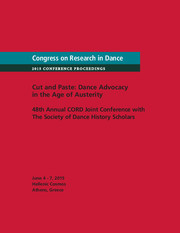No CrossRef data available.
Article contents
Floating Worlds: Japanese and American Transcultural Encounters in Dance
Published online by Cambridge University Press: 23 September 2014
Abstract
The repurposed metaphor “floating worlds,” from Japanese woodblock prints, highlights political junctions when transcultural American and Japanese dance collide and reconfigure. The first “floating world” is an “Ethiopian Concert” presented by Commodore Matthew Perry's Japanese Olio Minstrels in celebration of The Treaty of Peace and Amity (1854). The second challenges nostalgic Western notions of an “Old Japan” through the aggressively westernized Tokyo School of Music, where modern dancer Michio Ito trained for an opera career. Third, a post–World War I Peace Festival in Washington, DC, which included Ito's “eccentric dances,” documents an early Japanese diaspora within mainstream America. The final “floating world” conversely locates transcultural America outside of the United States through Ito's “Spirit of ’76” spectacle, staged for Occupied Forces following his unjust deportation to Japan. I apply analytical concepts of transcultural historians to imagine a global past that is less recognized, but no less nuanced, than the global present.
- Type
- Research Article
- Information
- Copyright
- Copyright © Marta Robertson 2014


